Australia is home to a remarkable array of wildlife, many of which are found nowhere else on Earth. However, numerous species are currently facing critical threats and are classified as endangered.
In this article, we explore some of Australia's most vulnerable creatures that you can observe in their natural habitats. Through the expert guidance of Australian Wildlife Journeys operators, you'll have the unique opportunity to witness these incredible animals up close while supporting their conservation.
From the elusive Tasmanian Devil in Tasmania to the majestic Whale Shark along the Ningaloo Reef, join us as we delve into the lives of these remarkable species and discover how you can enjoy special encounters and contribute to their preservation.
Australian Sea-lion
Scientific name: Neophoca cinerea
Status: Endangered
Regions: Kangaroo Island, South Australia; Eyre Peninsula, South Australia; Shoalwater Islands Marine Park, Western Australia.
The Australian Sea-lion, known for its playful behavior and small external ears, is found around the southern coast of Australia, including Kangaroo Island, the Eyre Peninsula, and Shoalwater Islands Marine Park near Perth. These sea-lions breed every 17-18 months, with females returning to their birthplace to breed.
Australian Sea-lions primarily feed on sea floor creatures like octopus and rock lobster and typically live 17-25 years, reaching breeding maturity at 12. They are listed as Endangered due to threats such as accidental drownings in gillnets from commercial fisheries.
Experiences vary in different regions. Kangaroo Island offers the chance to walk on the beach within the colony, whereas the Eyre Peninsula and Shoalwater Islands Marine Park offer swimming/snorkelling experiences.
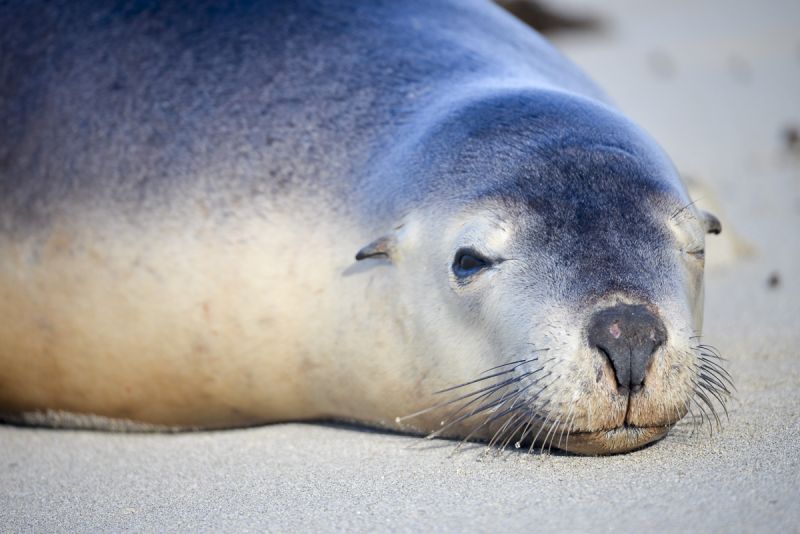
Featured Tour: Eyre Peninsula Wildlife & Ocean Encounters
Operator: Australian Coastal Safaris
Duration: 3 days
This three-day adventure combines the best terrestrial and marine protected areas across the region including the opportunity to swim with wild Sea-Lions and Bottlenose Dolphins, see Emus, wild Koalas and Kangaroos and the Rosenbergs Goanna!
Featured Tour: 3 Islands Wildlife Snorkel
Operator: Perth Wildlife Encounters
Duration: 4 hours
Immerse yourself in the pristine waters of the Shoalwater Islands Marine Park, on a snorkel adventure to encounter Australian Sea-lions, countless fish species along with seabirds and dolphins. Be mesmerised by the beautiful waters of this A-class Nature Reserve, exploring the best snorkelling spots in the bay, drifting over seagrass meadows and limestone reefs spotting fish and other marine life.
Featured Tour: Kangaroo Island In Style
Operator: Exceptional Kangaroo Island
Duration: 2 days
Discover what makes Kangaroo Island such a celebrated region, as you experience the Island's history, ecology, landscape, contemporary lifestyle, regional produce and incredible wildlife offerings. Regions visited include the Cygnet Valley, Stokes Bay, Flinders Chase National Park, central plateau and extraordinary south coast landscapes at Seal Bay, where guests will walk on the beach with Australian Sea-lions.
Powerful Owl
Scientific name: Ninox strenua
Status: Vulnerable (locally)
Region: East Gippsland, Victoria
The Powerful Owl, Australia's largest owl, commands attention with its deep, resonant double hoot and impressive wingspan of up to 140 cm. Inhabiting wet eucalyptus forests and rainforests in eastern Australia, it is also frequently seen in urban bushland where possums are abundant.
This formidable predator feeds on medium-sized mammals and birds, including young Koalas and Magpies. Although adaptable, the Powerful Owl is listed as vulnerable in Victoria, underscoring the importance of protecting its habitats, even as it continues to thrive in areas like the Dandenong Ranges and the eastern suburbs of Melbourne.

Featured Tour: East Gippsland Wildlife Journey
Operator: Echidna Walkabout Nature Tours
Duration: 4 days
Venturing across East Gippsland's magnificent lush rainforests, coastal heathlands, giant eucalypt groves, white sandy beaches and pristine rivers and estuaries, this four day immersive adventure offers you encounters with an incredible array of species.
Southern Cassowary
Scientific name: Casuarius casuarius johnsonii
Status: Endangered
Region: Daintree, Queensland
The Southern Cassowary is a striking and enigmatic bird, known for its vibrant blue and purple head, red wattles, and distinctive casque—a helmet-like structure on its head. While the exact function of this casque remains uncertain, recent research suggests it might help the cassowary detect low-frequency sounds, a sense shared with some dinosaurs and modern animals like elephants.
This flightless bird is notable for its unique feathers, which are long, glossy, and hair-like, with a quill that splits into two and lacks the usual barbules that hold feathers together. Cassowaries are solitary animals with a home range that can vary widely depending on food availability and breeding cycles.
Despite being a key figure in the Wet Tropics' ecosystem, where they help maintain rainforest diversity by dispersing large seeds, Southern Cassowaries are classified as Endangered in Queensland and Vulnerable by the IUCN. Their numbers are estimated at around 4,000 adults in Australia, and their habitat is increasingly fragmented by land clearing, roads, and other human activities.
Encounters with these impressive birds can be thrilling, but it is crucial to respect their space. Although sightings are not guaranteed, spending time in their habitat, especially with a guide, increases the chances of observing these remarkable birds.
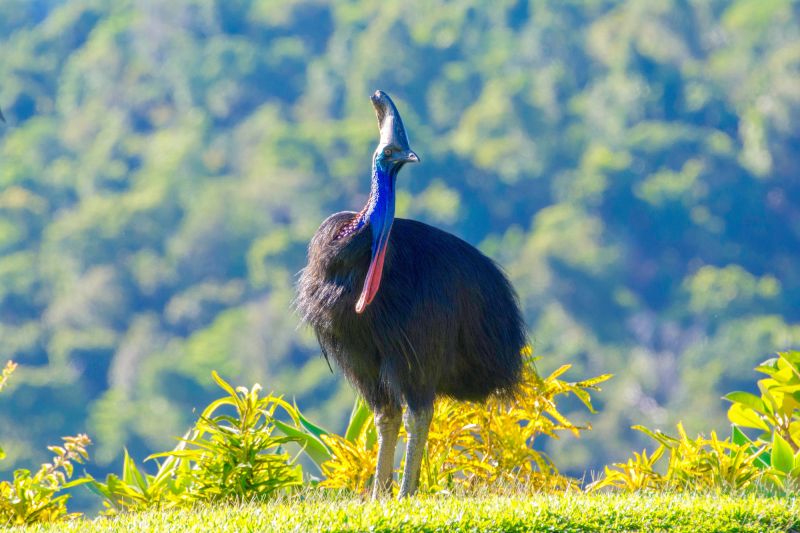
Featured Tour: 4 Day Nature, Wildlife & Conservation Safari
Operator: FNQ Nature Tours
Duration: 4 days
Far North Queensland is a wildlife enthusiast's paradise with this small group tour concentrating on the endemic wildlife found within Australia's most biodiverse region. Enjoy exclusive access to areas such as the Forever Wild Tropical Wetlands Shared Earth Reserve, a landscape of old growth savannah woodlands, lakes, swamps and creeks. It's not uncommon to observe a Southern Cassowary, tree kangaroo and platypus on a single tour!
Green Turtle
Scientific name: Chelonia mydas
Status: Vulnerable (locally)
Region: Frankland Islands, Queensland; Exmouth (Ningaloo Reef), Western Australia.
The Green Turtle is one of the world's largest sea turtles, with an average length of 1.2 meters (4 feet) and a weight of 225 kilograms (500 pounds). It ranks second in size only to the Leatherback Turtle. Due to threats from hunting, pollution, and other human-related factors, the global population is classified as endangered, and vulnerable in Australia.
These turtles are herbivores, primarily feeding on seagrasses, algae, and other marine plant matter. Their sharp, serrated beak enables them to graze efficiently on seagrass beds and scrape algae from rocks. This gentle feeding method actually benefits the seagrass beds, as they selectively eat the top of the leaves without disturbing the roots, promoting healthy and fast-growing seagrass.
You can snorkel with Green Turtles at Ningaloo Reef in Western Australia and the Frankland Islands on the Great Barrier Reef. These areas offer excellent opportunities to observe these magnificent creatures in their natural habitats.
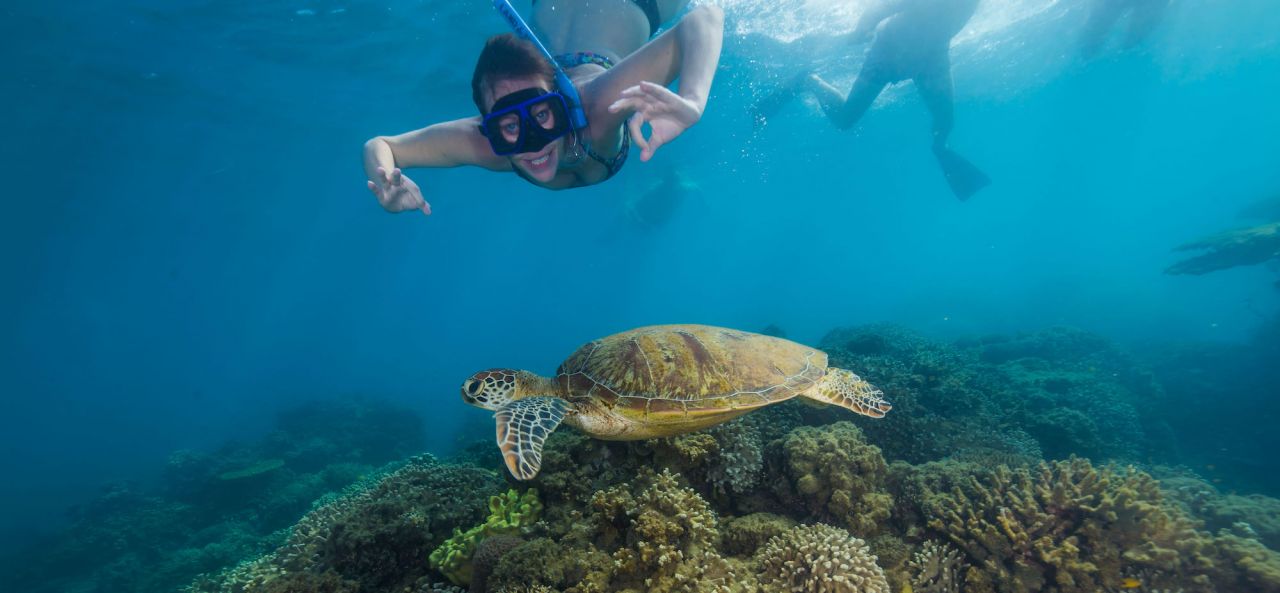
Featured Tour: Frankland Islands Reef Cruises Day Tour
Operator: Frankland Islands Reef Cruises
Duration: Full day
Spend the day at one of the most beautiful snorkelling locations on the Great Barrier Reef, with the opportunity to experience World Heritage-listed rivers, rainforests and reefs. Leave the crowds behind and enjoy exclusive access to the hidden treasure that is the Frankland Islands National Park. A magical underwater world of species awaits snorkellers, with Sea Turtles, Nudibranchs, Giant Clams, Butterflyfish, Angelfish & Parrotfish, Damselfish, Sea Cucumbers, stingrays, 200 species of coral and the famous Ocellaris Clownfish (Nemo) found in two rare jewel-blue anemones.
Featured Tour: Ningaloo Reef Diving Tour
Operator: Exmouth Dive & Whalesharks Ningaloo
Duration: Full day
Right on Exmouth's doorstep, dive the world famous Ningaloo Reef, on one of our three dive boats at Light House Bay, or the West Side. Whether you're a seasoned diver or keen to try for the first time - you're sure to have an awesome day as we visit two different dive sites! The Ningaloo Marine Park is regarded as one of the most beautiful underwater wilderness areas in Australia. The region boasts over 500 species of fish, 250 varieties of both soft & hard corals. See turtles, reef sharks, nudibranches, diverse fish and animal life!
Pink Cockatoo
Scientific name: Lophochroa leadbeateri leadbeateri
Status: Endangered
Region: Mungo National Park, New South Wales
The Pink Cockatoo is a striking bird, predominantly white with distinctive pink coloring on its head, neck, underbody, and wings. When its crest is raised, it reveals a vibrant red band with a yellow stripe, although it appears white when folded. This cockatoo thrives on a varied diet, including seeds from grasses and herbs, fruit, roots, bulbs, and insect larvae.
Primarily found in the inland regions of Australia, the Pink Cockatoo is commonly seen in dry woodlands and semi-arid areas, with Mungo National Park being a notable location for sightings. Despite its adaptability, the Pink Cockatoo's population has been adversely affected by habitat loss due to land clearing, which has diminished the availability of crucial nesting sites.
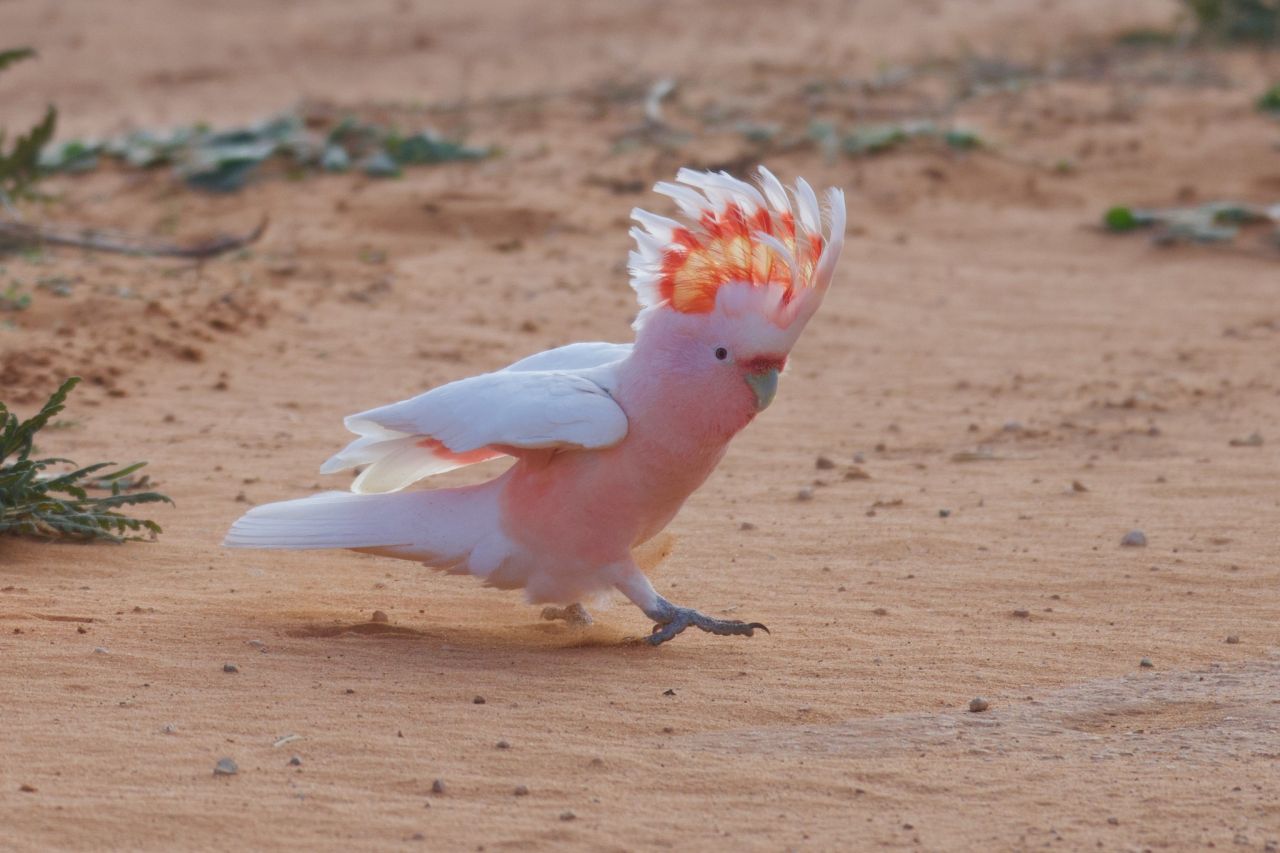
Featured Tour: Private Mungo Outback Tour
Operator: Echidna Walkabout Nature Tours
Duration: 4 days
Be captivated by the expansive red sand plains and dunes, riverine ecosystems of the famous Murray and Darling Rivers and the arid land ecosystems around Lake Mungo. Spot Kangaroos, Emus, Pink Cockatoos, several parrot species including Mulga, Red-rumped, Mallee Ringnecks and Blue-bonnets, raptor birds including the Wedge-tailed Eagle and several species of lizard basking in the sun.
Blue Whale
Scientific name: Balaenoptera musculus
Status: Endangered
Region: Dunsborough, Western Australia
Blue Whales, the largest animals on the planet, captivate with their sheer size and the mystery surrounding them. While previously thought to travel solo, recent observations have revealed that Blue Whales often move in pods, with groups of up to eight whales recorded.
In Western Australia's Geographe Bay (Dunsborough), where Blue Whales are commonly sighted from November to the end of the year, researchers monitor their behavior. They focus on pod dynamics, whale sizes, and the presence of calves. This data contributes to ongoing research efforts on whale populations in the region.

Featured Tour: Dunsborough Whale Watching
Operator: Naturaliste Charters
Duration: 2.5 hours
The tranquil waters off the beautiful town of Dunsborough, provide the perfect backdrop for travellers to regularly observe Humpback Whales, Southern Right Whales and the possibility of spotting the largest ever creature on earth, the Blue Whale, as they escort calves born in southward to Antarctica from October onwards.
Christmas Island Hawk-Owl
Scientific name: Ninox natalis
Status: Vulnerable
Region: Christmas Island
The Christmas Island Hawk-Owl, one of Australia's rarest raptors, is a striking bird known for its beautiful plumage and large yellow eyes. Measuring just 26 to 29 cm in height, this owl is roughly the size of a common pigeon but with a distinct barred breast. It has a unique boo-book call that often reveals its presence before it's seen. Endemic to Christmas Island in the Indian Ocean, this small nocturnal bird of prey inhabits various forest types across the island. It is most commonly found in primary forests, while post-mining regrowth areas are less frequented.
With a population of approximately 1,200 individuals, the Christmas Island Hawk-Owl is listed as vulnerable. Sadly, the total population has likely decreased by at least 25% since European settlement due to extensive deforestation on the island—about 25% of the island's forest has been cleared.
For the best chance to spot this elusive raptor, joining a local expert guide is recommended, as they are familiar with the bird's preferred haunts within the island's dense rainforests and coastal terraces.
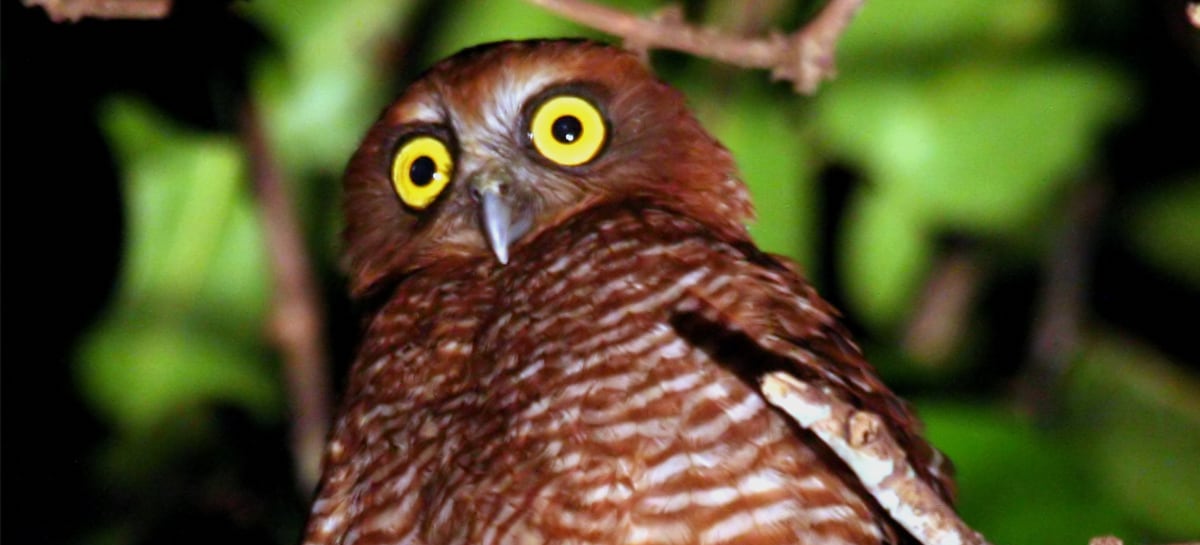
Featured Tour: Christmas Island Birdwatching
Operator: Indian Ocean Experiences
Duration: 8 days
Christmas Island is one of Australia's best birdwatching destinations. An internationally renowned seabird rookery, the island attracts about 80,000 nesting seabirds every year. Target species include the mesmerising Golden Bosun, Christmas Island Hawk-Owl, Abbott's Booby, Red-footed Booby, Brown Booby, Christmas Island Frigatebird, Christmas Island Goshawk, Red-tailed Tropicbird, Christmas Island Emerald Dove and Christmas Island Imperial Pigeon.
Tasmanian Devil
Scientific name: Sarcophilus harrisii
Status: Endangered
Region: Tasmania; Maria Island, Tasmania.
The Tasmanian Devil, Australia's largest carnivorous marsupial, is known for its robust build and distinctive scream. Once found across the Australian mainland, it disappeared due to predation by dingoes. Today, it primarily inhabits Tasmania, where it scavenges for food and occasionally hunts wallabies, possums, and wombats.
These nocturnal creatures are characterized by their strong jaws and a distinctive, spine-chilling scream. Their population has been severely impacted by Devil Facial Tumour Disease (DFTD), a transmissible cancer that has afflicted 90% of the population. Despite these challenges, conservation efforts have made significant strides.
Maria Island, located off the east coast of Tasmania, is a key site for the Tasmanian Devil's recovery. In 2012, fifteen Devils were introduced to the island as part of a rehabilitation program. The island's population has been steadily growing, free from the disease that plagues their mainland counterparts. Estimates suggest there are now close to 60 Tasmanian Devils on the island.
In addition to Maria Island, other areas in Tasmania also provide opportunities to see Tasmanian Devils, especially in regions where the disease has not yet spread. These efforts are crucial for preserving the species and ensuring its survival for future generations.
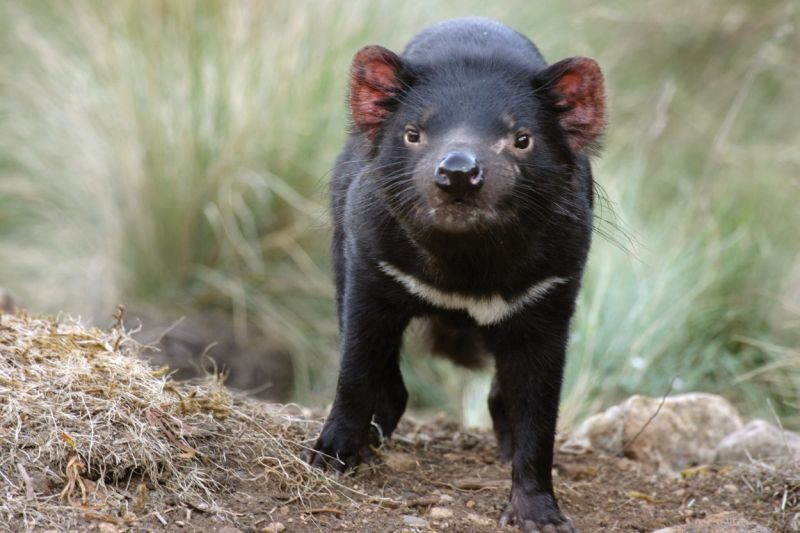
Featured Tour: The Maria Island Walk
Operator: The Maria Island Walk
Duration: 4 days
This four day guided walk across magnificent Maria Island, combines intimate wildlife encounters, fascinating history, pristine white sand beaches, and locally sourced gourmet food. As a vital location for numerous threatened and endangered species, Maria is now an island sanctuary and one of the best places in Australia to observe Common Wombats, Tasmanian Devils, Cape Barren Geese, Forester Kangaroos, Bennett's Wallabies and 125 species of birds; including all of Tasmania's endemics, the beautiful Swift Parrot and the endangered 40 Spotted Pardalote.
Featured Tour: 6 Day Tasmanian Devil Encounter Private
Operator: Premier Travel Tasmania
Duration: 6 days
Covering over one million hectares, the Tasmanian wilderness constitutes one of the last expanses of temperate rainforest in the world, officially recognised through a number of UNESCO World Heritage Listed areas. Kangaroos, wombats, quolls, Platypus, wombats and bird flourish here, but it is the island's most famous resident, the Tasmanian Devil, that is a highlight for many.
Kangaroo Island Short-beaked Echidna
Scientific name: Tachyglossus aculeatus multiaculeatus
Status: Endangered
Region: Kangaroo Island, South Australia
The Short-beaked Echidna, one of the world's most ancient mammals, boasts a fascinating array of unique traits and behaviors that underscore its importance in Australia's ecological history. While this species is found across the continent, the Kangaroo Island sub-species is endangered, making its conservation a priority.
During feeding, the echidna uses its long, sticky tongue—capable of extending up to 18 cm from the tip of its snout—to lap up ants, termites, and other insects at a remarkable rate of over 100 flicks per minute. This rapid tongue movement is reflected in its scientific name, with "tachy" meaning fast and "glossus" meaning tongue.
Though sightings are not guaranteed, spending three days or more on Kangaroo Island with an experienced guide significantly increases the chances of encountering this elusive creature.
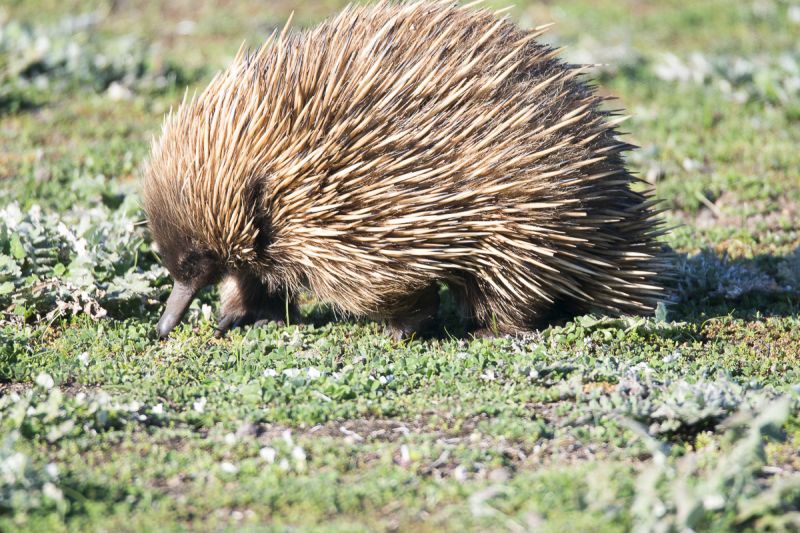
Featured Tour: Conservation Connection
Operator: Exceptional Kangaroo Island
Duration: 3 days
Venture out with some of Kangaroo Island's most respected researchers and conservation managers to gain an insight into key wildlife species, as well as enjoying the iconic landscapes and wildlife encounters the island is famous for. Meet with Dr Peggy Rismiller who is the world expert on short-beaked echidnas – one of the world's three egg-laying mammals. Over lunch, Peggy will share the results of 30 years investigating the lives of echidnas, goannas, tiger snakes and the broader ecology of Kangaroo Island.
Regent Parrot
Scientific name: Polytelis anthopeplus monarchoides
Status: Vulnerable
Region: Riverland, South Australia
The Regent Parrot is a striking bird with a slim build, long, tapering tail, and back-swept wings. Its vibrant yellow plumage contrasts with blue-black wings and tail, and it features a prominent yellow shoulder patch and red wing patches visible in flight. The bill is deep red or pink. Females and juveniles are duller, with olive-green feathers and less vivid wing markings.
Feeding mainly on seeds from grasses, plants, and cereal crops like wheat, the Regent Parrot also consumes buds, flowers, insect larvae, psyllids, and lerps. It forages in pairs or small groups, usually on the ground but also in tree canopies or on spilled grain. Typically seen in pairs or small flocks, larger groups form around abundant food sources. During breeding season, males may form single-sex flocks while females incubate eggs.
The Regent Parrot is found across South Australia's Riverland region, particularly along the Murray River. However, the population has become fragmented and declined due to the clearance of large areas of both breeding and foraging habitats, leading to its classification as vulnerable.
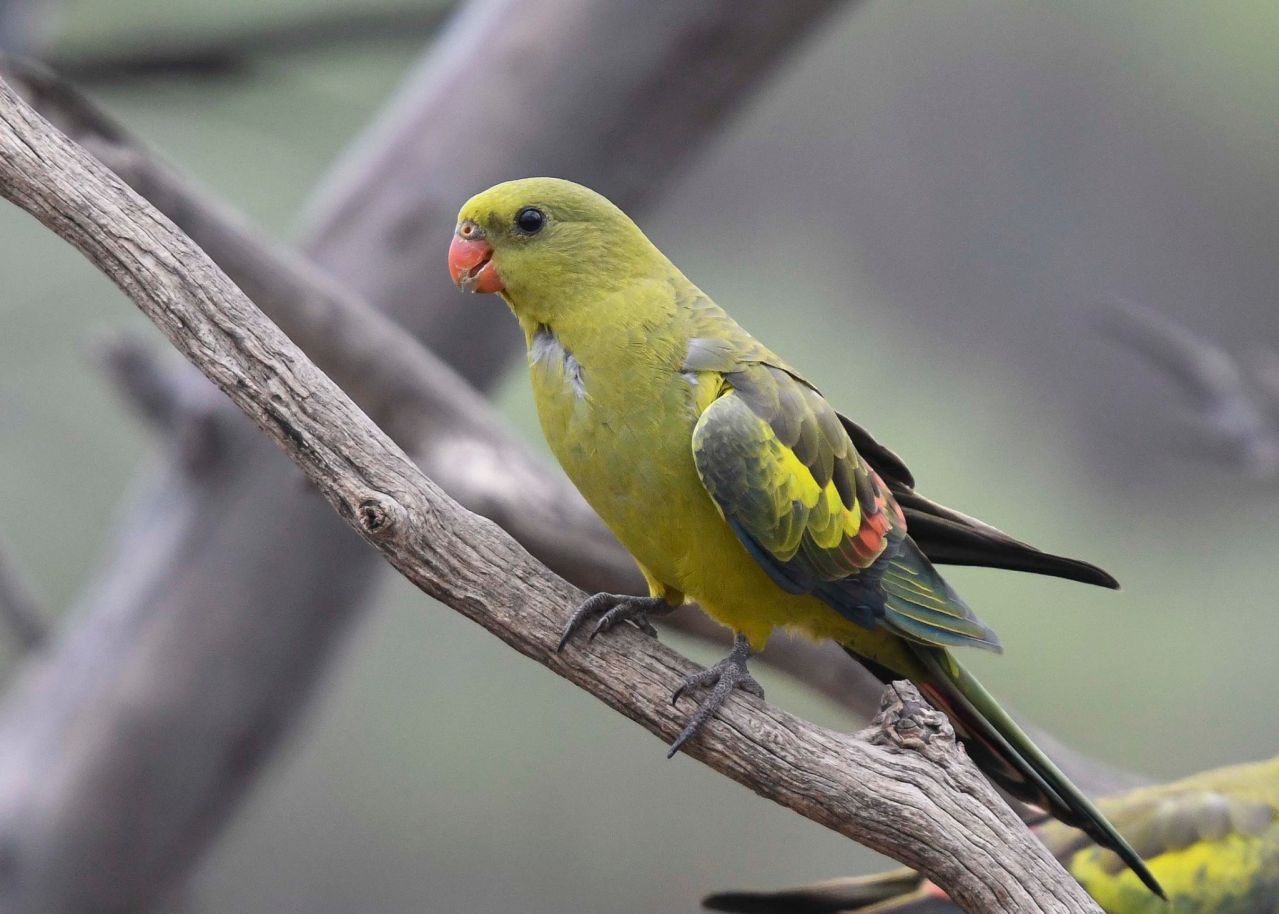
Featured Tour: Murray River Safari
Operator: Murray River Trails
Duration: 4 days
Experience the diverse wildlife offerings where Australia's river oasis meets the outback. This multi-activity wildlife safari along Australia's greatest river includes guided walks, canoeing, an outback drive and open back cruising, combined with luxurious houseboat accommodation and superb dining including local wines. Canoe through tranquil backwaters teeming with birdlife including ducks, darters, cormorants, kites and parrots, along with the opportunity to spot Western Grey Kangaroos and Lace Monitors.
Whale Shark
Scientific name: Rhincodon typus
Status: Vulnerable
Region: Exmouth (Ningaloo Reef), Western Australia
The Whale Shark is the world's largest fish, reaching lengths of up to 12 metres and boasting mouths that can grow to 1.5 metres wide. Despite their massive size, Whale Sharks are harmless to humans and feed on plankton and small fish by filtering water through their gills.
Each autumn, the Ningaloo Marine Park experiences a spectacular mass spawning of coral, which occurs about seven to ten days after the full moon in March and April. This spawning event triggers an influx of krill and plankton, drawing Whale Sharks to the area in large numbers. During this time, Whale Sharks are often seen hanging vertically at the water's surface with their mouths open to capture the rich food supply.
From March to August, you can swim with Whale Sharks along the Ningaloo Reef in Western Australia. Contrary to what one might expect from such a large 'shark,' Whale Sharks are slow and leisurely swimmers, cruising at speeds of no more than 5 km per hour (3.1 miles per hour). Unfortunately, the global population of Whale Sharks has declined by more than 50% over the last 75 years, leading to their classification as Endangered.
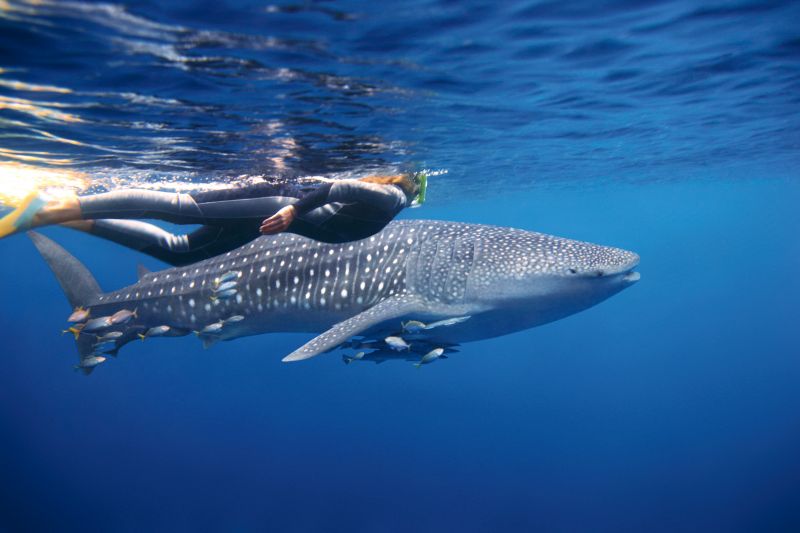
Featured Tour: Deluxe Whaleshark Swim
Operator: Exmouth Dive & Whalesharks Ningaloo
Duration: Full day
The opportunity to swim with the Whaleshark is one of the world's greatest interactive marine encounters.This unforgettable day starts early to board a beautifully equipped vessel, with the world's leading Whale Shark team. Using light aircraft to fly overhead during the day, the team will be directed to the locations of the whale sharks to provide the best opportunities to encounter these magnificent fish.
Tasmanian Wedge-tailed Eagle
Scientific name: Aquila audax fleayi
Status: Endangered
Region: Tasmania; Maria Island, Tasmania.
The Tasmanian Wedge-tailed Eagle is Australia's largest bird of prey, recognized for its distinctive wedge-shaped tail and impressive size. This subspecies, first identified in the 1950s, is notable for its pale plumage, which varies from buffy-white to golden or russet hues, and its larger size compared to mainland birds. The population of adult Tasmanian Wedge-tailed Eagles is estimated at fewer than 1,000 individuals.
Inhabiting a variety of habitats across Tasmania, including mature forests and offshore islands, these eagles are more commonly found on the east coast, such as Maria Island. They defend extensive territories and prey on reptiles, birds, and mammals.
Key threats to their survival include habitat loss, nest disturbance, collisions with artificial structures, electrocution, and persecution. Even minor disturbances, especially from people or helicopters, can significantly impact breeding success, potentially leading to nest abandonment. Conservation efforts focusing on protecting nests and reducing unnatural mortality rates are crucial for the species' future.
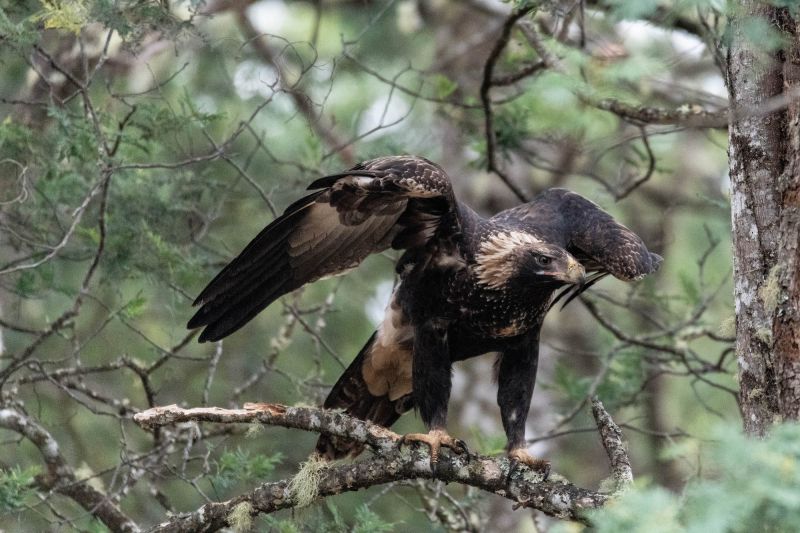
Featured Tour: 5 Day Tasmanian Wildlife Encounter
Operator: Premier Travel Tasmania
Duration: 5 days
Tasmania, Australia's island state, provides a rare opportunity to encounter unique and endemic wildlife. Renowned as a prime area for marsupial spotting, Tasmania is a crucial habitat for many species, including quolls, kangaroos, wallabies, wombats and the most famous resident, the Tasmanian Devil. Experience a mix of beautiful eucalypt forests, spectacular coastlines, and tranquil bays, including Maria Island, Freycinet Peninsula, Bay of Fires and Cataract Gorge.
Featured Tour: The Maria Island Walk
Operator: The Maria Island Walk
Duration: 4 days
This four day guided walk across magnificent Maria Island, combines intimate wildlife encounters, fascinating history, pristine white sand beaches, and locally sourced gourmet food. As a vital location for numerous threatened and endangered species, Maria is now an island sanctuary and one of the best places in Australia to observe Common Wombats, Tasmanian Devils, Cape Barren Geese, Forester Kangaroos, Bennett's Wallabies and 125 species of birds; including all of Tasmania's endemics, the beautiful Swift Parrot and the endangered 40 Spotted Pardalote.
Encountering endangered species in the wild is not only a profound experience but also an essential step in raising awareness and supporting conservation efforts. By exploring these unique habitats with our knowledgeable tour operators, you're contributing to the protection and understanding of these incredible animals.
We hope this blog inspires you to embark on a journey to see these species in the wild and to support ongoing efforts to ensure their future.

